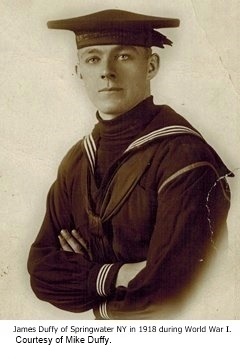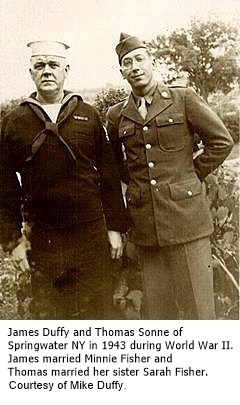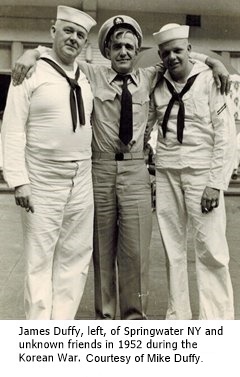
Welcome to Hemlock and Canadice Lakes!
Barns Businesses Cemeteries Churches Clinton & Sullivan Columns Communities Documents Events Time Line Fairs & Festivals Farm & Garden Hiking Homesteads Lake Cottages Lake Scenes Landscapes Library News Articles Old Maps Old Roads & Bridges Organizations People Photo Gallery Podcasts Railroad Reservoir Schools State Forest Veterans Videos
|
James J. Duffy |
|
|
1 James Duffy as he appeared in 1918 during World War I. Click an image to enlarge. Photo courtesy of Mike Duffy. |
2 James Duffy and Thomas Sonne as they appeared in 1943 during World War II. Thomas was married to Sarah Fisher. Photo courtesy of Mike Duffy. |
3 James Duffy, left, and unknown friends as they appeared in 1952 during the Korean War. Photo courtesy of MikeDuffy. |
|
A Biography of James Duffy By Mike Duffy Triple war veteran James Duffy enlisted in the U.S. Navy during World Wars I and II and the Korean War. James was born at the home of his parents at 96 Bolton Street, Boston, Massachusetts. He ran away from home at about age 11 and worked aboard coal freighters. At age 16 in early 1913 James was attending some type of school in New York City but left in the summer of 1913 to work on the farm of Elmer Colegrove at Springwater, Livingston, New York. He remained at Springwater until leaving for Boston in 1917 to enlist in the U.S. Navy. He returned to Springwater after being discharged from the Navy in 1919. He married Minnie Fisher 7 Nov 1919 at Springwater, NY. They had three children who were George, Dorothy and John. James Joseph Duffy military service record: WW I, 12 June 1917 - 21 June 1919, Leviathan WW II, 23 June 1943 - 9 Aug 1945, Quincy CA-71 Korea, 30 Sep 1950 - 2 July 1954, New Jersey BB-62, Bennington CVA- 20 James served on the USS Leviathan 1917 - 1919, a troop transport which was the largest passenger ship in the world at the time. It was formerly the SS Vaterland, an Imperator class German luxury liner that was seized at Hoboken when the United States entered the war. James made 14 round trip crossings from Hoboken to Liverpool or Brest. On one occasion the Leviathan fought a running battle with 5 German U-boats, five of which were destroyed by depth charges or gun fire. The remaining soldiers of the famous 27th Division were carried home aboard the Leviathan shortly after the armistice was signed. James served with Hollywood actor Humphrey Bogart on the Leviathan. James was aboard when future US president Franklin Roosevelt traveled on the Leviathan to Europe and back in his capacity as Assistant Secretary of the US Navy under Woodrow Wilson. On 23 June 1943 James became a “re-tread” with his second enlistment in the Navy. His ship in that war was the USS Quincy, CA-71, a Baltimore class heavy cruiser. At that time the Quincy was the largest, heaviest and fastest cruiser in the world. James visited 18 countries with the Quincy. They fought German airplanes and shore batteries at Normandy, Toulon, Cherbourg and Marseille. They also carried President Franklin Roosevelt to the Yalta Conference. Special lifts were built into the ship to accommodate the President’s need for a wheelchair. After the successful invasion of Europe, James and the Quincy moved to the Pacific arena where they fought Japanese Kamikaze planes in the battle for Okinawa as well as other Japanese strongholds. Preparing for the invasion of Japan, the Quincy made several forays along the Japanese coast while shelling the mainland and offshore islands. On August 8, 1945 James added his second honorable discharge to his collection. In 1947 he joined the U.S. Naval Reserve Corps. On September 20, 1950 James was recalled to active duty for the Korean conflict and assigned to the New Jersey, BB-62, an Iowa class battleship. In addition to his duties of maintaining and operating the power plants aboard ship, James was Master of Arms for the starboard side of the ship. James next served aboard the USS Bennington, CVA-20, which was the most advanced carrier in the world at the time. On 27 April, a downcomer tube in Boiler Room One slipped loose which caused an explosion that killed 11 men, and seriously wounded four others. James was in the area of the explosion but was blasted out of the boiler area and survived. At 08:11 on 26 May 1954, while cruising off Narragansett Bay, fluid in one of the catapults exploded, setting off a series of secondary explosions which killed 103 crewmen and injured 201 others. This tragedy caused the Navy to switch from hydraulic catapults to steam catapults for launching aircraft. James was in his mid-50’s during these two incidents and much older than most of his shipmates. The deaths of the many young sailors weighed heavily upon him for the remainder of his life. James was honorably discharged for the third and final time on July 2, 1954. |
|
The Obituary of James Duffy 27th March 1897 - 23rd December 1966 One of the few survivors of three American wars was buried here yesterday to the sound of bugles, rifle reports, and gently falling snow. James. J. Duffy, 69, of School Street Springwater NY died Friday in the Canandaigua VA Hospital. He enlisted in the Navy during World Wars I and II and during the Korean War. Born in Boston on March 27, 1897 to Hugh and Margaret Barrett Duffy, he enlisted in the Navy for the first time in 1917. He served two years aboard the USS Leviathan, a troop ship, as a boiler technician. During World War II Duffy served on the USS Quincey. He was aboard when the late President Franklin D. Roosevelt was taken to the Yalta Peace Conference, said his widow, Mrs. Minnie Duffy, Springwater Town Clerk. Duffy was injured during the Korean War when explosions ripped the USS Bennington, on which he served from 1951 to 1955. He was stationed on the USS New Jersey for nine months in 1950 before transfer to the Bennington. Mr. and Mrs. Duffy were married in Springwater on the 3rd of Novemeber, 1919. Duffy worked at the C. F. Cannon Co. between the wars. He was a charter member of an American Legion post in Boston and was a charter member of the Kern - Robinson post in Springwater. Post Commander Ronald Proctor said Duffy was the post’s only life member and held county and state Legion offices. Duffy was buried in Mt. Vernon Evergreen Cemetery in Springwater. The rifle salute was given by a squad of Navy men from the U. S. Naval Reserve Training Center at Horseheads, Lt. John S. Herrmann commanding. Mrs. Duffy was presented the U.S. flag by J. Reid Robinson, a World War I Navy veteran from Springwater. Bearers were Harold Francis and Robinson, World War I veterans; Keith Straight and Leo Colegrove, World War II veterans, Ronald Proctor and Norman Fox, Korean War Veterans; and Richard Miller and Gerald Finn, servicemen on leave from active duty. Survivors besides his widow are a son, John C.; two sisters, Mrs. Winnie Conell and Mrs. Marguerite Burns; two brothers, Joseph and John all of Boston, and three grandchildren. 
Veteran of WW I, WW II and the Korean War
|
|
The Burial of James Duffy The Springwater Mt. Vernon - Evergreen Cemetery
|
||


